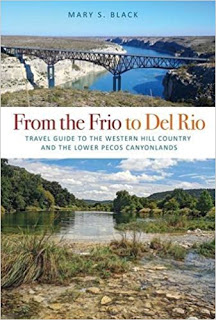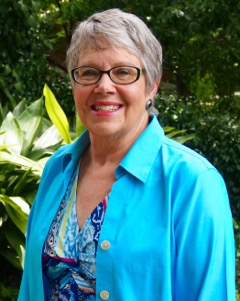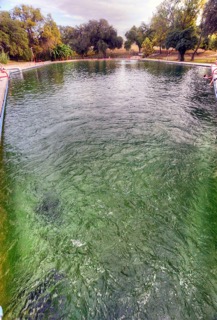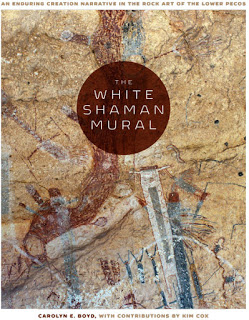
“The Lower Pecos Canyonlands are not well known by most people, but the landscape is incredibly majestic and unexpected.” — Mary S. Black
This blog posts on Mondays. Fourth Mondays of the month I devote to a Q & A with a fellow writer.
This finds me taking this Monday off so, herewith, an especially inspiring Q & A from the archives.
Q & A: Mary S. Black on Her New Book,
From the Frío to Del Río
Originally posted May 22, 2017 on Madam Mayo blog

One of my very favorite places not just in Texas but in the galaxy is the Lower Pecos Canyonlands, so I was delighted to see that Texas A & M Press has published Mary S. Black’s splendid and much-needed guidebook, From the Frio to Del Rio: Travel Guide to the Western Hill Country and Lower Pecos Canyonlands.
From the catalog:
“Each year, more than two million visitors enjoy the attractions of the Western Hill Country, with Uvalde as its portal, and the lower Pecos River canyonlands, which stretch roughly along US 90 from Brackettville, through Del Rio, and on to the west. Amistad National Recreation Area, the Judge Roy Bean Visitors’ Center and Botanical Garden, Seminole Canyon State Park, and the Briscoe-Garner Museum in Uvalde, along with ghost towns, ancient rock art, sweeping vistas, and unique flora and fauna, are just a few of the features that make this distinctive section of the Lone Star State an enticing destination.
“Now, veteran writer, blogger, and educator Mary S. Black serves up the best of this region’s special adventures and secret treasures. From the Frio to Del Rio is chock-full of helpful maps, colorful photography, and tips on where to stay, what to do, and how to get there. In addition there are details for 10 scenic routes, 3 historic forts and 7 state parks and other recreation areas.”

C.M. MAYO: What inspired you to write this book?
MARY S. BLACK: I think what inspired me was the land itself, and the history. The Lower Pecos Canyonlands are not well known by most people, but the landscape is incredibly majestic and unexpected. You can be driving 70 miles per hour down the highway through the desert, when, wham, a huge canyon veers off to the left like a sudden tear in the earth.
These canyons were inhabited by human beings for thousands of years. They lived off the land and made paintings on the canyon walls that illustrate their gods and belief systems. Over 300 of these paintings still exist, and you can visit some of them. They are a treasure of human culture, and I hope more people will learn to value them as something important for us to save. The people who settled this area historically were a diverse bunch with a lot of gumption. Do people know that word anymore? I guess in modern language, we might say they had a lot of guts.
C.M. MAYO: In your view, what is the most underrated place in this region?
MARY S. BLACK: If I have to pick only one, I’ll say Las Moras Springs Pool at Ft. Clark in Brackettville. I’m always looking for great swimming holes. Las Moras Springs Pool is the third largest spring-fed swimming pool in Texas. Crystal clear water at a year-round temperature of about 70 degrees comes into the pool from a strongly flowing spring, yet very few people swim there because they don’t know how to get access.
The pool is located on Ft. Clark, and old U.S. Army fort originally built in 1849. You can get a day-pass for $5.00 at the guard house to enter the fort, enjoy the pool or play golf on either of two gold courses, and look at all the old stone buildings that remain from when the place was an active Army fort. There is also a really interesting museum there that is open on Saturdays.

C.M. MAYO: Which is your favorite place?
MARY S. BLACK: Hands down, the White Shaman Preserve. The best studied of all the ancient murals is located there. This is a polychrome painting about 25 feet long and 13 feet high done on a rock wall overlooking the Pecos River. This painting tells a story about creation and how the sun was born, according to Dr. Carolyn Boyd. You can visit the preserve on Saturdays at noon if you make a reservation online through the Witte Museum. Tours are two-three hours long, and require a fairly strenuous hike down a canyon to a rockshelter, then back up. But to be up there, to see the mural up close and in person, to look out over the river and imagine the people who made this painting, can change your whole perspective. It’s that powerful.
C.M. MAYO: Your favorite seasonal or annual event?
MARY S. BLACK: I have two: autumn color near Lost Maples State Natural Area near Vanderpool, and tubing in the cold Frio river in summer. Both are unique experiences in Texas and shouldn’t be missed. An isolated stand of bigtooth maple turns orange and red in Sabinal Canyon in late November. And swimming in the Frio at Garner State Park is like heaven on a hot day.
C.M. MAYO: What surprised you in researching this book?
MARY S. BLACK: How fascinating the area really is. The more I learned, the more I wanted to know. The region has seven state parks and natural areas, nine ghost towns, three historic Army forts, and many scenic drives. But the coolest part was reading about all the crazy things that have happened there, like train robberies and early airplane adventures. And Indian battles. When settlers from the US and Mexico started coming in after the Civil War, the native Apaches and Comanches were fighting for their lives. And of course the U.S. Army was trying to drive them out. It gets complicated, but there were many interesting people involved in all this, like the Black Seminole Indian Scouts at Ft. Clark, and others. One of the first settlers in the Nueces River valley was a woman named Jerusha Sanchez, who came in the 1860s. Later a widow named Elizabeth Hill and her three sons also pioneered in the area. Blacks, women, immigrants from Italy, Mexico, Germany, and other places, and Native Americans made the history what it is.
C.M. MAYO: You offer an excellent bibliography for further reading. If you could recommend only three of these books, which would they be?
MARY S. BLACK: Hmm, they are so different, let me see. First I think Carolyn Boyd’s new book, which is called simply The White Shaman Mural, just published by University of Texas Press in 2016. She details her 25 years of research on the painting in this book and explains how she cracked the code on what it means, an amazing accomplishment.

Then I nominate Judge Roy Bean Country by Jack Skiles, published in 1996, which is a compilation of local stories of life in the Lower Pecos. The Skiles family has been ranching in the area for over 75 years and can tell stories about mountain lions and smugglers that will make you faint.
Finally, one I found fascinating was The Newton Boys: Portrait of an Outlaw Gang by Willis and Joe Newton as told to Claude Stanush, published in 1994. It tells how they became train robbers and learned to blow bank safes with nitroglycerin, which they did in Texas and the Midwest all through the 1920s. By the time they were captured, they had stolen more money than all other outlaws at the time combined.
> Mary S. Black’s website and blog
> From the Frio to Del Rio is available from amazon.com or your independent bookseller.
I welcome your courteous comments which, should you feel so moved, you can email to me here.

Carolyn Boyd’s The White Shaman Mural
Selected Cabeza de Vaca Books, Part I:
Notes on the Two Editions of Cabeza de Vaca’s La Relación
(Also Known as Account, Chronicle, Narrative, Castaways,
Report & etc.)
and Selected English Translations
Q & A with Biographer David O. Stewart on
the Stunning Fact of George Washington

